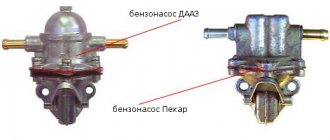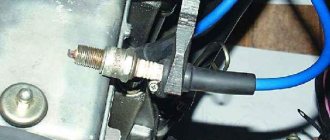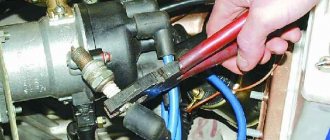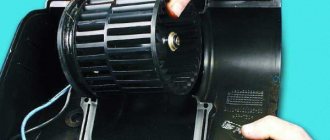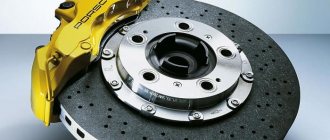The design of any modern car, the VAZ 2114 is no exception, is such that the successful production of a car depends on a number of positions. Previously, this was enough for the mechanical pump to supply fuel to the carburetor, and for the spark plugs to produce a spark. Today there are a lot of problems that prevent the engine from starting. An electronic injector requires the participation of several sensors, and the matter is not limited to them. In this article we will tell you why not and how to deal with it.
In general, all causes of malfunction can be divided into two large categories:
- Fuel system problems. This group includes any breakdowns as a result of which fuel is not supplied to the engine at all, is supplied incorrectly, or mixture quality errors occur.
- Electrical problems. Ignition of the fuel mixture is ensured by sending an electrical signal to the spark plugs. If problems arise here (and there are a huge number of electrical elements), the car will not start.
The most terrible malfunctions can be included in a separate category - for example, a “knocking” VAZ 2114 engine, a broken timing belt and, as a result, bending of the valves. In these situations, expensive repairs cannot be avoided.
Fuel system problems
Among the elements of the fuel system, the following factors influence engine starting:
- presence of gasoline in the tank;
- the integrity of the fuel lines under the “belly” of the car;
- cleanliness of the filters: coarse cleaning (located in the tank) and fine cleaning (located under the car, to the right of the spare wheel compartment).
Also included in this category are electrical components that are directly related to the fuel supply. This is an electric fuel pump and a fuel pump relay.
Before checking other methods, you must be completely sure that the VAZ 2114 with an injector is filled. “Yes, there are still five liters there” according to the indicator on the tidy or “I filled it up yesterday, I couldn’t spend that much” are not suitable. The gauge may be lying, and there may be leaks in the tank or fuel lines. Carefully check the car for fuel leaks; just in case, fill in 5-7 liters of gasoline from a canister.
The mesh in the tank rarely gets clogged, leave this option for last, but it’s worth trying to change the fine filter if electrical problems are ruled out.
The operation of the fuel pump is checked by ear (after turning the key, its operation should be heard; if not, the pump has “died”, or the pump relay, or a wiring break). According to the manual, you need to connect a pressure gauge to the fuel system. If the pressure does not stay within 2-2.5 atm, the VAZ 2114 will not catch due to insufficient fuel pressure.
Low voltage circuit
Using a 12V lamp, you can check the low voltage circuit. The lamp must be connected with the first contact to the low voltage terminal, and the second to the car body. Next, you need to close the distributor contacts and start the ignition. If the circuit is OK, the lamp will light when the contacts open and go out when the contacts close.
If the lamp does not light up when the contacts are opened, this means that the problem is in the low voltage wiring or in the ignition coil, or rather, in its winding.
There is a special offer on our website. You can get a free consultation with our corporate lawyer by simply submitting your question in the form below.
Electrical faults
Most of the problems lie here, so we’ll look at each option in detail here:
Nothing happens when I turn the key
On a VAZ 2114, this usually indicates a violation in the ignition switch - starter line, but one of the reasons for the breakdown “for blondes” is a dead battery, do not forget about it (checked with a voltmeter: it should be at least 11.8 V - and with a hydrometer, if the battery is serviceable : at least 1.22 in each jar).
Let's move on. The cause of such a malfunction may be a breakdown of the ignition switch cylinder, and the injector has nothing to do with it. If, when turning the key, new sensations arise (something catches, turning has become easier or, conversely, more difficult), that’s the problem.
Under the panel, approximately above the clutch, there are two relays: ignition switch and starter release. The reason may be a malfunction of one of them. They are checked according to the manual by a good electrician or replaced with a known working one.
Starter. Often the cause may be a jammed “retractor”. If you are standing in a field, you should try hitting it with something heavy like a large key (without fanaticism) - it may help. If the car is parked in a garage, you should remove the starter and try to start it directly from the battery.
To do this, press the housing to the zero terminal of the battery, install the wire with the alligator clip on the positive terminal of the battery and bring it to the positive of the retractor. If the starter tries to jump out of your hands, everything is fine (be careful, it is not recommended to carry out this procedure without basic knowledge of safety precautions and an assistant!).
If there is no reaction, the problem is in the retractor. If the relay buzzes, but the starter does not turn, the problem is in the brushes. If the starter makes a terrible sound, but does not turn, the problem is in the bendix.
If the starter turns, replace the battery and check the power supply to the chips that are connected to the starter (with an assistant, one turns the key, the other measures it with a multimeter).
Also pay attention to the ground wire that goes to the battery. If there are breaks in the wiring at the point of contact with the body or at the terminal, it must be replaced. It is also worth disconnecting the wire from the body and thoroughly cleaning it with a metal brush. The reason for the failure to start may be simple oxidation.
The starter turns, but the car does not start
This is the most common situation in the case of the VAZ 2114. The procedure for solving it must begin with answering the question of whether there is a spark. To do this, take an assistant, unscrew one spark plug, put an armor wire on it and very carefully (avoid touching live parts, hold the insulated part of the wire) apply the spark plug to the cylinder head cover. While the assistant turns the engine, watch the behavior of the spark plug. If there is no spark, you need to look for it.
If there's no spark
The ignition module is one of the key problems of the VAZ 2114 on the injector. It breaks often and sometimes a new one comes with a defect. You can read more about checking the ignition module in other material on our website. Please note that the problem may also lie in the chip that is connected to the module. The presence of power on it must also be checked.
DPCV is another reason why there may be no spark. Since this sensor monitors the firing phases of the cylinders, it is one of the key elements of the ignition system. Note that the probability of its failure is lower than that of the ignition module. It is checked by an electrician using an oscilloscope; garage methods do not provide an accurate assessment of the condition of the sensor (only replacement with a guaranteed working one).
ECU. “January” is a relatively reliable injector, but the “brains” can also malfunction from time to time. Often the problem with them is identified by a violation of the injection phases: for example, a spark is supplied only to cylinders 2 and 4, or only to cylinders 1 and 3. Sometimes the issue can be resolved by simply cleaning the contacts on the ECU chip; it is also subject to oxidation, which causes signal loss.
If there's a spark
Not often, but this problem does happen. By all indications, the car should start (gasoline splashes into the ramp, the starter turns, there is a spark), but the engine does not catch. There are also pitfalls here.
Injectors. In most cases, the problem is in them; it is worth taking the car for diagnostics and cleaning it with ultrasound. If trouble strikes you on the road, pay attention to the candles. If the injector supplies the mixture, they must be filled with gasoline; if the spark plugs are dry, the probability of an injector malfunction is high. However, keep in mind that injectors rarely fail suddenly and all at once. As a rule, the engine should start running before the car stops starting.
Poor quality gasoline. It is assumed that a serviceable engine should start almost on water, unless it runs poorly. In reality this is nonsense. There are enough examples of “dead” engines after refueling (both at “Uncle Ashot” and at completely official gas stations of well-known brands). Keep this in mind. If the car stops gripping immediately or a short time after refueling, you should not discount this option. The solution is to drain the gasoline and add another.
Lack of required pressure in the ramp. Here we return to problems with the fuel system. Perhaps the problem is the pump or problems with the TPS (unlikely). If you have January 7.2, the cause may be a malfunction of the mass air flow sensor. Unlike January 5.1, here this sensor is polled at startup and, if there is an error, the ECU may prevent the engine from starting.
Finally, we note that the reasons for non-starting in the presence of gasoline and spark may include the following:
- the phases are incorrectly set when replacing the timing belt, as well as its breakage or rotation - it’s worth checking;
- due to overheating, the cylinder head “started”;
- uneven compression in the cylinders, “stacking” of the rings.
Unplanted VAZ 2114 is a common situation, and there are many reasons that cause it. Therefore, it is worth approaching this issue fully armed.
No spark VAZ (injector, 8 valves)
The other day, out of the blue, the car (Kalina 1.6, 8 valves) began to shake terribly. Diagnostics showed misfires in cylinders 1 and 4. After a little checking (see how to check correctly here), I came to the conclusion that there was no spark . And only in cylinders 1-4.
Next, in order to find out the reason for the loss of spark, I will go in order.
The first thing to check is the spark plugs. The spark plug looked normal, so I didn’t have much hope that replacing it would fix the situation. And so it happened - the new spark plug still refused to produce a spark.
This is interesting: The starter turns poorly when the battery is charged
The second is checking high-voltage wires. They are checked with a conventional multimeter in resistance measurement mode. The resistance should be within 15 kOhm. The wires also turned out to be fine.
Third, and probably most important, is the ignition coil. She, like no one else, is responsible for the spark. Its operability is also checked with a multimeter in continuity and resistance measurement mode. First you need to check the resistance between pins 1-4 and 2-3. It should be about 4 kOhm. If the tester shows infinity, then the coil is broken and must be completely replaced. Next, check the resistance between pins 1a and 1b. There shouldn't be a break here. And the last thing is to check the central contact for breakdown to the housing. The tester should show infinity.
My reel passed the test perfectly. It seems that all the main parts are working properly, so why is there no spark? After digging a little on the Internet, I realized that I still need to check the circuit from the ECU to the coil itself.
A 3-pin chip is placed on the ignition coil, therefore you need to check these 3 wires. The central contact is +12V, which is constantly supplied when the ignition is on. The extreme contacts - 1a and 1b - provide a control signal (negative) at the moment when a spark is needed. How can all this be checked? Very simple - using a regular light bulb.
We connect the lamp to the central terminal and contact 1a and ask a partner to crank the engine a little (first remove the fuel pump fuse and relieve the pressure in the rail). When cranking the starter, the lamp should flash. The same procedure must be done with pin 1b - the lamp should also blink.
When I turned on the ignition, the lamp started to light up, just constantly on (pin 1b and central). This means that the control wire has a short to ground somewhere or that the transistor (VT1) in the ECU is broken. To find out, we need to find the ECU, disconnect the wiring harness from it, find the wires we need (1b) and test them for integrity.
Having found the contact diagram, I found out that contact 1b goes to pin 5 of the ECU, 1a goes to pin 2, 3 goes to ground of the ignition circuit. I rang them for integrity - they were all intact. I called ground and everything is fine too. Therefore, you need to check the transistor in the controller itself.
My car has a January 7.2 controller. Inside there are 2 transistors that pass control signals to pins 1a and 1b of the ignition coil. So one of these transistors was broken, i.e. was constantly in the open position.
How to check the transistor for serviceability? It has 3 pins - 2 of which are soldered. It is necessary to ring each outer terminal with the central one. In both cases, the tester should not beep. The contacts must not be closed.
Now all that’s left to do is to unsolder the broken transistor (its marking is gb10nb37lz), solder a new one in its place and rejoice at the spark that appears.
No spark on cylinders 1 and 4 of the VAZ 2114: troubleshooting
The reasons why cylinders 1 and 4 of the VAZ 2114 do not work may be:
- Candles.
- Wires.
- Ignition module.
- Control block.
We talked about how to check the spark plugs above, so let's move on to the wires. To check, you will need a tester (multimeter), with which you should check all high-voltage wires (you should measure in ohmmeter mode).
The resistance of all four wires should be approximately the same and not exceed 200 kOhm. If the resistance is significantly higher than specified or the resistance of some wires is very different from the resistance of others, then they should be replaced with similar ones.
If the wires are in good condition, we proceed to checking the module.
To check it, you should use a self-diagnostic scanner connected to a laptop or smartphone (the connection can be via Bluetooth, Wi-Fi, or a USB cable).
The scanner displays the test results on the screen of the mobile device using standardized codes.
The most common of them (indicating that the ignition module is damaged) are the following:
- P3000, P3001, P3002, P3003, P3004 - no spark in the cylinders (the last digit is equal to the cylinder number). In our case there should be signals P3001 and P3004;
- P0351 - a rupture occurred inside the ignition module on the windings responsible for cylinders 1 and 4;
- P0352 - the same thing, but the break occurred on the windings of cylinders 2 and 3.
If the above errors are detected as a result of the scan, then the module is burnt out and should be replaced with a new one (since it is not a repairable component).
There is no spark in the VAZ 2114 car
Probably, many car enthusiasts have encountered a problem when there is no spark on the high voltage wires, so if the vehicle engine does not start, but the driver hears the functioning of the fuel pump in the tank, then you need to pay attention to the ignition system. One of the most common problems with a car's ignition system is that there is simply no spark at high voltage wiring. That is why the main topic of today’s article will be the following questions:
Why are there no sparks on high voltage wiring? What to do if there are no sparks on the high-voltage wiring of the VAZ 2114?
Naturally, in addition to these questions, we will consider several more and here are a few of them:
- What is the ignition system of the VAZ 2114 car injector?
- Diagnostics of the electronic part of the VAZ 2114 system;
- The main breakdowns encountered by the ignition system of a VAZ 2114 car;
- The main signs of failure of the ignition module of the VAZ 2114 injector;
- Diagnostics of the ignition module VAZ 2114 injector;
- Algorithm for removing and installing the ignition module VAZ 2114 injector;
- How to check whether sparks occur or not?
- What to do if there is no spark on a VAZ 2114 car?
VAZ 2114 does not start reasons
Factors that influence indirectly or directly on the formation of causes are varied and are expressed mainly by signs of malfunctions of two machine systems:
- fuel (manifests itself in the fact that 2114 does not start, stalls while driving and does not start);
- ignition system electrician.
In addition to common reasons, there are those that require expensive repairs, these include:
- engine malfunction;
- broken timing belt.
Repairing a carburetor type is cheaper and easier than an injection type.
VAZ 2114 injection type 8 valves does not start due to:
- clogged injectors;
- refueling with low-quality gasoline;
- decreasing the pressure level in the ramp.
Basic information about the ignition system of a VAZ 2114 car
An injector is a method of guiding a car's engine system. In addition, it is a method of supplying the fuel mixture.
On cars with an injection engine, the fuel mixture is supplied using a computer through special nozzles. Most likely, every car owner has ever encountered a problem when there is no spark on the high voltage wires, but the driver can hear how the fuel pump functions, then pay attention to the ignition system of your vehicle. One of the most common problems with a car's ignition system is that there is simply no spark at high voltage wiring.
During operation of the machine, some malfunctions of electrical components may occur and this may affect the functioning of:
- Instruments, and this does not make it possible to control the ignition system and other components;
- power unit, thereby making it impossible to develop standard power;
- Light fixtures and convenience mechanisms, which include lighting, heating and power windows.
The main breakdowns encountered by the ignition system of a VAZ 2114 car:
- Reduced vehicle power;
- Failure during the development of vehicle engine power;
- Idle speed instability;
- Violation of the normal functioning of the cylinder.
You need to start looking for the cause of malfunctions in the ignition system with the formation of sparks on high voltage wiring.
Sparking process
If you hear the fuel pump operating, but there are no sparks on the high-voltage wiring, then check the functioning of the ignition system. The system is checked for the presence of sparks on high voltage wiring, and for this a special device called a spark gap is used. The use of this device is considered more comfortable, because most injector-type engines use static ignition distribution with simultaneous transmission of high voltage to two spark plugs.
To carry out such a test, you need to connect the spark gap and crank the engine using the starter. If sparks appear only on one of the wires, then the reason is a breakdown at the wire ground or at the coil terminal. Sometimes the reason may be a broken wiring or winding that relates to the car's ignition system module.
If there are no sparks on several wires at the same time in any sequence, then the cause of the malfunction lies in the coil, module or vehicle controller.
Please note that damage may occur due to the fact that the high voltage wiring line is broken. In this case, it is necessary to check the high voltage wiring for integrity, and this can be done by taking measurements of the resistance level of the wiring itself. The standard resistance value on the wiring should be no more than 200 kilo-ohms. It is also worth paying your attention to the fact that there should not be a large difference between the resistance levels of the wiring.
Ignition module on a VAZ 2114 car
If the discharge of sparks from high-voltage wiring has always been stable, this indicates that the cause of malfunctions in the injection engine lies in the spark plugs.
If there are no sparks, then the cause of the malfunction may lie in the primary circuit that runs from the generator to the ignition coil. Most often, the cause is a malfunction of the ignition module, and the easiest way to determine whether this is the cause or not is to establish a properly functioning device. That is, if sparks appeared after replacement, then the problem was in the ignition module, and the instructions for use do not provide for its repair.
Algorithm for removing and installing the VAZ 2114 injector ignition module:
- Disconnect the negative terminal on the battery or using the ground disconnect button;
- Remove the tip from all candles;
- We bend the clamp, disconnecting the low voltage wiring block of the module;
- Disconnect the high voltage wiring from the module connectors;
- We unscrew the 2 bolts securing the crankcase to the engine using a 13mm wrench;
- We loosen the 3rd bolt together with the head using a 17 wrench;
- Remove the module together with the bracket;
- Unscrew the bolts securing the module to the bracket. They are located under the hexagon;
- Installation occurs in reverse order.
If sparks still do not begin to form, then it is very likely that the reason lies in the controller or the wiring connecting the module and the ignition coil. In this case, you need to check for the presence of sparks on all cylinders one by one, and if there is no spark on one coil, then replace it with the one next to it. If after replacing one coil with another a spark appears, then the reason is a broken coil, otherwise the controller or wiring is broken.
Possible reasons
The loss of a spark in an engine is a rather broad topic, but if you do not go deeper, but only understand what the formation of a spark in a VAZ 2114 engine depends on, then you can use the method of elimination and verification to find the culprit of the problem. Most often, the spark disappears for trivial reasons, such as sensor failure, problems with spark plugs, etc. breakdowns that can be resolved fairly quickly and do not require large financial costs. But there are also very expensive parts, the breakdown of which leads to loss of spark.
Reasons why there is no spark in the VAZ 2114:
- Spark plug;
- High voltage wires;
- Ignition module;
- Crankshaft position sensor;
- Crankshaft pulley;
- The engine control unit;
As you can see, there are quite a few reasons why a spark may be missing, so it won’t be difficult to figure out this problem, you just need to follow the advice from this article and you will succeed.
So, let's look at each of the reasons in more detail to understand how it can affect the formation of this problem.
Spark plug
How correctly, in the absence of a spark, the engine will stop starting and the first thing you need to check is the part that produces this spark.
To check the spark plugs, they need to be unscrewed and checked, but, as a rule, all spark plugs cannot fail at the same time, and if this happens, the chance of this happening is negligible. If there is no spark on only one of the cylinders.
Diagnostics of spark plugs
You can make a conclusion about the serviceability of a spark plug not only by checking the presence of a spark on it, but even by its external condition and carbon deposits.
Below is a picture that characterizes a candle by its soot.
Checking for a spark on the spark plug
To check the spark plug to find out whether it generates a spark or not, you can use a special tester for spark plugs or connect it to a high-voltage wire, lean it on the engine body and crank the engine using the starter.
When checking spark plugs, you need to be careful and not hold the high-voltage wire with your hands, as high voltage flows there. The spark plug must be held by the wire using pliers with insulated handles.
High voltage wires
The high voltage wire delivers high voltage from the ignition module to the spark plug. It is made of silicone insulation, inside of which a conductor is placed. The voltage flowing through these wires reaches 40,000 volts, so it is very important that the insulation of such wires is very strong and has a high insulation resistance.
Over time, when motor products such as oil, antifreeze, moisture, etc. get on the insulation of the wires. it begins to deteriorate and lose its properties, which can lead to insulation breakdown and loss of spark. When a breakdown occurs in the wire, the spark is not delivered to the spark plug and, therefore, ignition does not occur in the combustion chamber, which leads to misfire.
Checking wires
You can check the wires by measuring their resistance using a conventional multimeter. To do this, you need to remove the wire from the car and measure the resistance on it.
We turn the switch on the multimeter to the parameter for measuring resistance with a limit of 20 kOhm and connect the probes of the device to the two ends of the wire.
The resistance of a serviceable high-voltage wire of a VAZ 2114 varies from 4 to 10 kOhm.
Ignition module
The spark generator on a car is a kind of spark generator, which is responsible for its presence and formation in the system. The ignition module is based on two coils, which are responsible for the operation of 4 cylinders, one coil for cylinders 1-4, the second coil for cylinders 2-3.
If there is no spark on two cylinders (1-4; 2-3) at once, then the ignition module is most likely faulty and requires replacement.
The module is checked using a multimeter using resistance measurement parameters.
It is also quite common that power to the MZ is lost due to corrosion of the electrical wiring or oxidation of the contacts. It is necessary to check the presence of voltage at the module power connector and draw the appropriate conclusions.
Crankshaft position sensor
This part is used to read the TDC position from the crankshaft. Based on these readings, the ECU sends a signal to the ignition module, which supplies voltage to the spark plug.
If this sensor fails, there will be no spark in the car and starting the internal combustion engine will be impossible.
Causes of DPKV failure:
- Contamination or oxidation of the connector;
- A large amount of chips on the magnet;
- Damage to the power circuit;
If there is no spark on the VAZ 2114, special attention must be paid to the DPKV.
Crankshaft pulley
Although the pulley is a completely mechanical part, it also participates in the process of spark formation. This part works in tandem with the DPKV; there are protrusions on the pulley from which the sensor reads readings and understands what position the crankshaft is currently in.
It happens that the pulley is damaged and begins to rotate out of alignment with the DPKV, which leads to the inability to read the readings and, consequently, to the absence of a spark.
Pulley with torn damper
Also, some VAZ 2114 kernel pulleys have a rubber damper layer, which peels off from the metal over time and the working part of the pulley rotates, thereby knocking down the marks by which the DPKV determines TDC.
The engine control unit
The ECU is responsible for all processes in the operation of not only the engine, but the entire car. This part is the brain center of the entire car and controls all injector sensors. It happens that in the event of a short circuit or other damage, the sensor control keys may burn out, which will lead to loss of communication between the sensor and the ECU, and this equates to a sensor failure.
Such a breakdown can only be repaired by a qualified electrician, since it is necessary to disassemble the computer and resolder the transistors.
If the transistor responsible for the operation of the ignition module burns out, then the formation of a spark will become impossible.
VAZ 2114: no spark injector
A very good opportunity has arisen to show in practice how to look for a fault on VAZ fuel-injected cars. Here we have a clear, understated nine. Now I’ll show you something else interesting. Problem: won't start. Primary diagnostics showed that there is no spark, and now we will look for the reason. In order to determine the reason, we need to look at the signals on the connector...*. Now let's turn on the ignition and take a look.
This is interesting: Checking the starter from the battery
We must have a ground indicator on the connector....* On the connector we have plus 12 V and ground, and also two control signals. We can now see the control signals, or should, in any case, see them when the starter rotates. We should hear a squeak. But there are no squeaks, because the control signals also do not arrive, so there is no spark. You can also check the signals on the injectors, but there are none either, so you can’t do without diagnostics and a computer (computer).
As I said earlier, when you turn on the ignition, look at the “Check” light. The light is on, which means the brains are turned on. We also listen to the fuel pump - the fuel pump turns on. And when the starter rotates, the fuel pump turns on again, this indicates that the crankshaft position sensor, if faulty, is at least receiving some impulses. The injectors do not open. Just in case, I turned off the immobilizer, it is located here, I just pulled out the connector. Accordingly, the diagnostics, of course, will not work now, but you never know... And, since it is not clear what is the reason for the lack of a spark and injectors*, suspicion fell on a glitchy immobilizer. And now we are flashing the block. I downloaded the firmware, removed the immobilizer from the firmware and uploaded it back.
How to save 20% fuel?
This thing really saves 10-30% on gasoline. You simply install this device on the fuel supply hose and...
My homemade adapter is used. Let's connect to the brains...* The loader used is this one - CombiLoader, this version is like this. I downloaded the firmware for myself, I’ll read why this firmware is cool. Maybe people saw it that way according to the version, I don’t know. Usually, when I repair a car, I use standard water and there are no more problems. And then all sorts of Sports, Economy and others - you won’t understand later that it* works so poorly. I'll show you the results.
I deceived you, unfortunately, I won’t show you how the problem was solved. And the problem was quite interesting. It seems that, based on the first signs, the crankshaft sensor was alive, one might say “conditionally alive”, because when the crankshaft rotated, the fuel pump turned on again and I, as it were, temporarily got rid of this problem. But, as it turned out later, the car had recently been repaired, the head was removed, and inexperienced mechanics laid a wire leading to the crankshaft position sensor near the exhaust manifold.
The wire melted and one of the wires shorted to the braid. For those who don’t know, there is a shielded cable in which two wires are laid. Surprisingly, the brain recognized the pulse in this position and turned on the actuator, that is, the fuel pump relay was turned on, but, accordingly, the engine control unit* was unable to calculate the position of the top dead center, or calculate the position of the pulses. I noticed it purely by chance (I was already freezing, I had no time for filming), just moving the wire near the crankshaft position sensor.
I took it off, checked the sensor - the sensor seemed to start* correctly. Pulling the wire, rotating the starter, the engine began to seize. At this point it became clear that the problem was with the wiring, and after looking carefully at the wire, I saw that it was burnt out. I cut out the damaged area, connected it - and the car started up perfectly and drove away*. It was already dark, I wanted to go home, so there was no time for filming. Nevertheless, I am reporting on the results and a little bit (about) my technique, which I talked about a little earlier in the video, about how to find a spark - the sensor can turn on the pump and at the same time not give a spark - a very interesting case came across. I think you'll take note.
